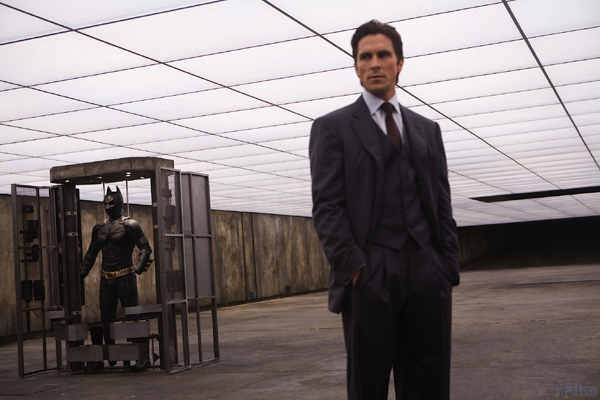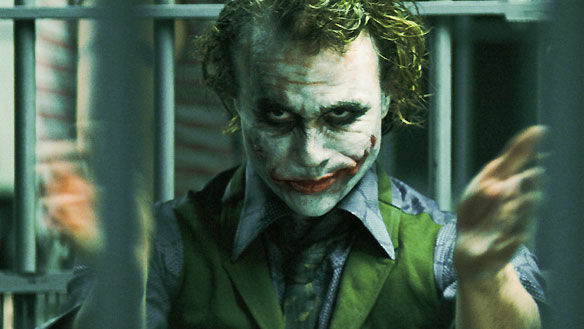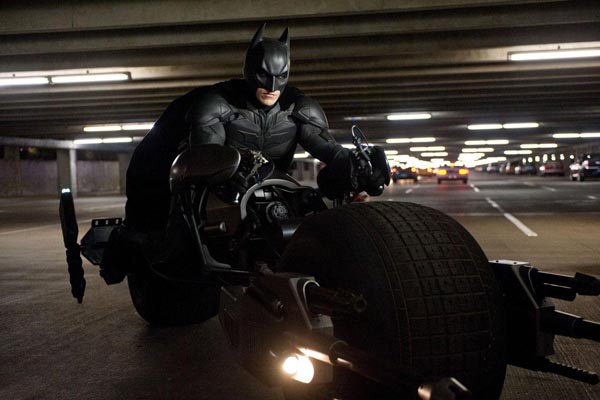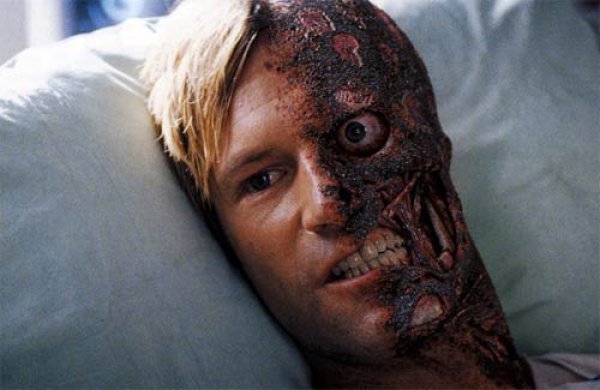The Dark Knight: A Retrospective Review
If you need a reminder of why
The Dark Knight Rises is the most anticipated film in years, just watch
The Dark Knight — one more time. Christopher Nolan’s sequel never disappoints.
Second films in superhero movie franchises have been especially good this side of the 21st Century, and it’s no secret that a lack of obligation to the origin story is the key. Christian Bale’s Bruce Wayne has already decided to wear the cowl and stand as a symbol for what is right — now he can have some fun.

That’s where the Joker comes in, bringing all that makes
The Dark Knight great along with him. Heath Ledger’s wildly creative and unpredictable Oscar-winning performance is just the surface of some incredibly thorough and complex thinking.
When you break down Nolan and David S. Goyer’s approach to the use of villains in their Batman universe, you notice that each is a symbol. Batman, too, is a symbol, and his journey in this series has been one of discovering exactly what symbol Gotham City needs him to be.
The villains so far have symbolized powerful influences over humankind, namely whether we choose to be good or evil. So it’s not just good guy vs. bad guy clashing in these movies, it’s symbol for good vs. symbol for evil and that’s what makes the films so powerful.
Ra’s Al Ghul represented fear and therefore attempted to use fear to drive man against man knowing the seedy, weak Gotham would tear itself apart. As Joker so plainly states, he is an “agent of chaos.” Driven by a mad desire to see the order that is so central to modern-day society stripped down to its carnal, animalistic self-preservation-driven roots, he attempted to expose the weaknesses of our establishments and social constructs to prove humans are inherently anarchistic.

The story and script of
The Dark Knight builds around this new addition of the chaos factor. The film begins in a Gotham whose citizens have been inspired by Batman not to be afraid of the mob and take back their city. This includes the brazen new D.A. Harvey Dent (Aaron Eckhart), who Bruce realizes could take his place as Gotham’s symbol for good, not to mention one that is more in line with the law than a masked vigilante. With Dent capable of putting the whole Falcone crime ring behind bars, Gotham’s new dawn looks to be on the horizon — until the Joker proves quite the wild card.
The Joker recognizes the dangerous symbol Batman has become — as well as the thrilling adversary he poses — and convinces the mob to lend him its resources in order to bring Gotham back into enough of a chaotic state that the mob can grab hold again. His motivation? Proving his point.
The weakest yet the most exhilarating part of
The Dark Knight is how Joker goes about making his point. For a man who hates plans, he seems to have all of what happens in the film extremely well thought out with no margin for error. Yet those who champion the film as among the best they’ve seen (myself included) will argue that the script’s theory and ideology supersedes its need to be realistic. After all, have we gotten so caught up in the grit and realism of Nolan’s Bat-verse that we’ve forgotten Batman’s a comic book character?

You also have to respect how effortlessly contrived the Joker’s many moves are in the film starting with targeting the judge, the commissioner and Harvey Dent all the way to the classic prisoner’s dilemma scenario on the ferries. Nolan, his brother and Goyer dream up the perfect scenarios to slowly unveil the power of Joker’s ideology and social theory, not to mention that many of them double for exciting, large-scale action sequences. Blockbusters are never this in touch with their themes, and when they are, the dialogue used to spout them never comes off this convincingly.
The Dark Knight backs up all its dialogue with action and all its action with dialogue — the synchronicity is almost uncanny.
Hiding in there is the unbelievably powerful story line of Harvey Dent. How the film is able to weave Dent’s rise and fall/transformation into Two-Face inside the Batman/Joker face-off and equip it with the adequate emotional pull deserves a damn Pulitzer. I don’t care what they award Pulitzer’s for, Nolan and co. deserve one.

We see what Bruce sees in Dent, his fearlessness, and we understand his pain when the love of his life is taken from him. Then our jaws drop and our heads shake in horror as he gives in to Joker’s anarchy sermon and decides that the only pure form of justice is chance. The symbolism of Dent’s fall from grace as seen in the blackened coin and when Batman flips his head to one side at the end evokes a message that Bob Kane himself probably never even dreamed about.
And that leaves us with the resonance, the chills that go up our spine as Gary Oldman’s Commissioner Gordon tells his son why Batman has run off, why sometimes a hero’s job involves not being a hero at all. Everything to that point has built to that moment of realization for Bruce Wayne, while simultaneously casting a tremendous shadow of doubt over the sequel. How will Batman ever become the hero to lead Gotham out of the darkness if he must sacrifice everything he’s done to this point?
Oh Friday, please get here already.
 That’s where the Joker comes in, bringing all that makes The Dark Knight great along with him. Heath Ledger’s wildly creative and unpredictable Oscar-winning performance is just the surface of some incredibly thorough and complex thinking.
When you break down Nolan and David S. Goyer’s approach to the use of villains in their Batman universe, you notice that each is a symbol. Batman, too, is a symbol, and his journey in this series has been one of discovering exactly what symbol Gotham City needs him to be.
The villains so far have symbolized powerful influences over humankind, namely whether we choose to be good or evil. So it’s not just good guy vs. bad guy clashing in these movies, it’s symbol for good vs. symbol for evil and that’s what makes the films so powerful.
Ra’s Al Ghul represented fear and therefore attempted to use fear to drive man against man knowing the seedy, weak Gotham would tear itself apart. As Joker so plainly states, he is an “agent of chaos.” Driven by a mad desire to see the order that is so central to modern-day society stripped down to its carnal, animalistic self-preservation-driven roots, he attempted to expose the weaknesses of our establishments and social constructs to prove humans are inherently anarchistic.
That’s where the Joker comes in, bringing all that makes The Dark Knight great along with him. Heath Ledger’s wildly creative and unpredictable Oscar-winning performance is just the surface of some incredibly thorough and complex thinking.
When you break down Nolan and David S. Goyer’s approach to the use of villains in their Batman universe, you notice that each is a symbol. Batman, too, is a symbol, and his journey in this series has been one of discovering exactly what symbol Gotham City needs him to be.
The villains so far have symbolized powerful influences over humankind, namely whether we choose to be good or evil. So it’s not just good guy vs. bad guy clashing in these movies, it’s symbol for good vs. symbol for evil and that’s what makes the films so powerful.
Ra’s Al Ghul represented fear and therefore attempted to use fear to drive man against man knowing the seedy, weak Gotham would tear itself apart. As Joker so plainly states, he is an “agent of chaos.” Driven by a mad desire to see the order that is so central to modern-day society stripped down to its carnal, animalistic self-preservation-driven roots, he attempted to expose the weaknesses of our establishments and social constructs to prove humans are inherently anarchistic.
 The story and script of The Dark Knight builds around this new addition of the chaos factor. The film begins in a Gotham whose citizens have been inspired by Batman not to be afraid of the mob and take back their city. This includes the brazen new D.A. Harvey Dent (Aaron Eckhart), who Bruce realizes could take his place as Gotham’s symbol for good, not to mention one that is more in line with the law than a masked vigilante. With Dent capable of putting the whole Falcone crime ring behind bars, Gotham’s new dawn looks to be on the horizon — until the Joker proves quite the wild card.
The Joker recognizes the dangerous symbol Batman has become — as well as the thrilling adversary he poses — and convinces the mob to lend him its resources in order to bring Gotham back into enough of a chaotic state that the mob can grab hold again. His motivation? Proving his point.
The weakest yet the most exhilarating part of The Dark Knight is how Joker goes about making his point. For a man who hates plans, he seems to have all of what happens in the film extremely well thought out with no margin for error. Yet those who champion the film as among the best they’ve seen (myself included) will argue that the script’s theory and ideology supersedes its need to be realistic. After all, have we gotten so caught up in the grit and realism of Nolan’s Bat-verse that we’ve forgotten Batman’s a comic book character?
The story and script of The Dark Knight builds around this new addition of the chaos factor. The film begins in a Gotham whose citizens have been inspired by Batman not to be afraid of the mob and take back their city. This includes the brazen new D.A. Harvey Dent (Aaron Eckhart), who Bruce realizes could take his place as Gotham’s symbol for good, not to mention one that is more in line with the law than a masked vigilante. With Dent capable of putting the whole Falcone crime ring behind bars, Gotham’s new dawn looks to be on the horizon — until the Joker proves quite the wild card.
The Joker recognizes the dangerous symbol Batman has become — as well as the thrilling adversary he poses — and convinces the mob to lend him its resources in order to bring Gotham back into enough of a chaotic state that the mob can grab hold again. His motivation? Proving his point.
The weakest yet the most exhilarating part of The Dark Knight is how Joker goes about making his point. For a man who hates plans, he seems to have all of what happens in the film extremely well thought out with no margin for error. Yet those who champion the film as among the best they’ve seen (myself included) will argue that the script’s theory and ideology supersedes its need to be realistic. After all, have we gotten so caught up in the grit and realism of Nolan’s Bat-verse that we’ve forgotten Batman’s a comic book character?
 You also have to respect how effortlessly contrived the Joker’s many moves are in the film starting with targeting the judge, the commissioner and Harvey Dent all the way to the classic prisoner’s dilemma scenario on the ferries. Nolan, his brother and Goyer dream up the perfect scenarios to slowly unveil the power of Joker’s ideology and social theory, not to mention that many of them double for exciting, large-scale action sequences. Blockbusters are never this in touch with their themes, and when they are, the dialogue used to spout them never comes off this convincingly. The Dark Knight backs up all its dialogue with action and all its action with dialogue — the synchronicity is almost uncanny.
Hiding in there is the unbelievably powerful story line of Harvey Dent. How the film is able to weave Dent’s rise and fall/transformation into Two-Face inside the Batman/Joker face-off and equip it with the adequate emotional pull deserves a damn Pulitzer. I don’t care what they award Pulitzer’s for, Nolan and co. deserve one.
You also have to respect how effortlessly contrived the Joker’s many moves are in the film starting with targeting the judge, the commissioner and Harvey Dent all the way to the classic prisoner’s dilemma scenario on the ferries. Nolan, his brother and Goyer dream up the perfect scenarios to slowly unveil the power of Joker’s ideology and social theory, not to mention that many of them double for exciting, large-scale action sequences. Blockbusters are never this in touch with their themes, and when they are, the dialogue used to spout them never comes off this convincingly. The Dark Knight backs up all its dialogue with action and all its action with dialogue — the synchronicity is almost uncanny.
Hiding in there is the unbelievably powerful story line of Harvey Dent. How the film is able to weave Dent’s rise and fall/transformation into Two-Face inside the Batman/Joker face-off and equip it with the adequate emotional pull deserves a damn Pulitzer. I don’t care what they award Pulitzer’s for, Nolan and co. deserve one.
 We see what Bruce sees in Dent, his fearlessness, and we understand his pain when the love of his life is taken from him. Then our jaws drop and our heads shake in horror as he gives in to Joker’s anarchy sermon and decides that the only pure form of justice is chance. The symbolism of Dent’s fall from grace as seen in the blackened coin and when Batman flips his head to one side at the end evokes a message that Bob Kane himself probably never even dreamed about.
And that leaves us with the resonance, the chills that go up our spine as Gary Oldman’s Commissioner Gordon tells his son why Batman has run off, why sometimes a hero’s job involves not being a hero at all. Everything to that point has built to that moment of realization for Bruce Wayne, while simultaneously casting a tremendous shadow of doubt over the sequel. How will Batman ever become the hero to lead Gotham out of the darkness if he must sacrifice everything he’s done to this point?
Oh Friday, please get here already.
We see what Bruce sees in Dent, his fearlessness, and we understand his pain when the love of his life is taken from him. Then our jaws drop and our heads shake in horror as he gives in to Joker’s anarchy sermon and decides that the only pure form of justice is chance. The symbolism of Dent’s fall from grace as seen in the blackened coin and when Batman flips his head to one side at the end evokes a message that Bob Kane himself probably never even dreamed about.
And that leaves us with the resonance, the chills that go up our spine as Gary Oldman’s Commissioner Gordon tells his son why Batman has run off, why sometimes a hero’s job involves not being a hero at all. Everything to that point has built to that moment of realization for Bruce Wayne, while simultaneously casting a tremendous shadow of doubt over the sequel. How will Batman ever become the hero to lead Gotham out of the darkness if he must sacrifice everything he’s done to this point?
Oh Friday, please get here already.